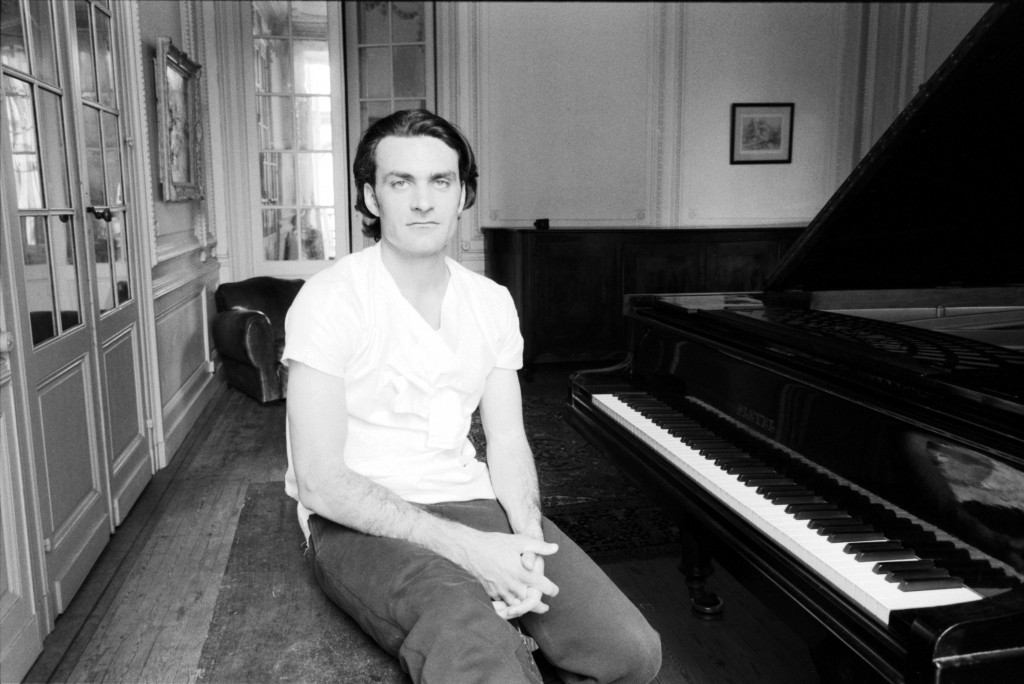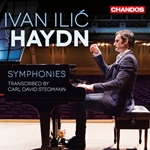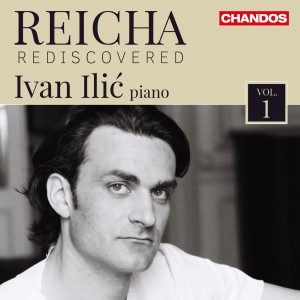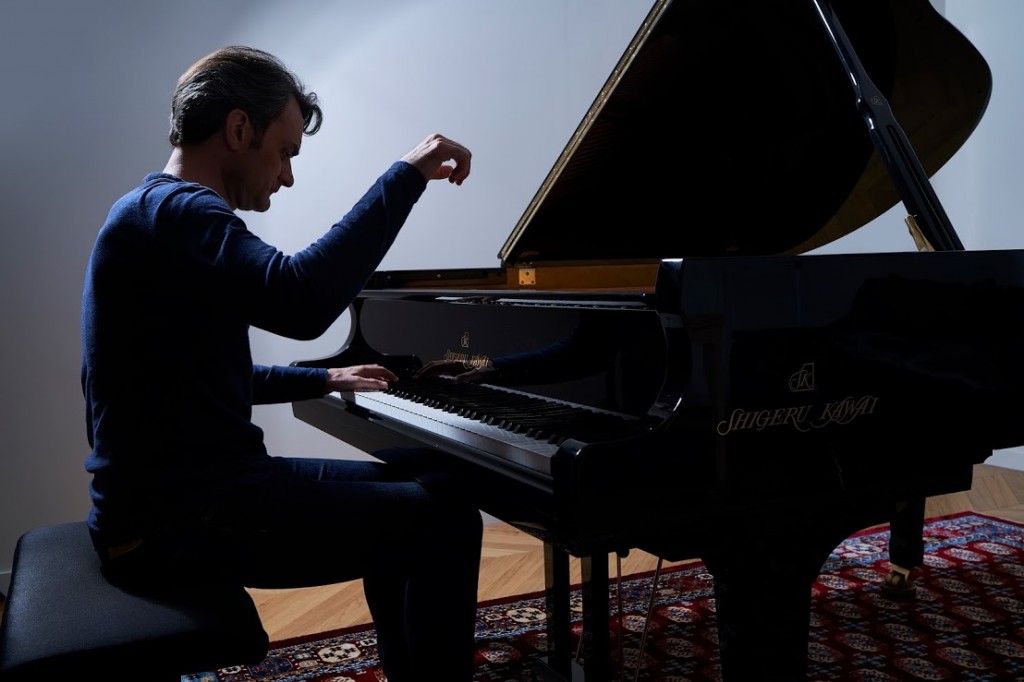This is a story of connecting dots. Some months ago, while I was surfing on the Internet, I ended up reading about the Quatuor Scientifique (scientific quartet) by Anton Reicha. There was a new recording being released by the Reicha Quartet on Brilliant Classics. And it seemed to be the only recording to date of that strange string quartet, which I found fascinating —it has twelve movements out of which nine are fugues!!—, by Reicha. I listened to it and then I told a friend of mine, the great violinist Mikhail Pochekin, about it. It was Mikhail who some days later sent me a link to a video of some Reicha piano works. On that video appeared a pianist of whom I had never heard before: Ivan Ilic. I did some research and I found that he had recorded some unpublished piano works by Anton Reicha. I downloaded from iTunes his two Reicha CDs on Chandos which I found really, really interesting and new to me. Then I wrote a little article on Reicha’s music based on what I had learnt from listening to Ivan Ilic’s recordings and videos. Some time later, I connected to Ivan Ilic via Twitter and Facebook —yes, the wonders of 21st century technology!— and we both shared some impressions online. By the beginning of August 2019, a new CD on Haydn symphonies transcribed by Carl David Stegmann (1751-1826) for the piano was released on Chandos. Guess who was the pianist: Ivan Ilic! So, I decided to get in touch with him and ask him whether he would be interested in an interview that I would later publish on my blog. And here you are! This is the result of connecting the dots in music!
I read the booklet, in which you explained how you found Carl David Stegmann’s transcriptions of Haydn’s Symphonies. But what led you from Reicha to Haydn, as your last recordings for Chandos were of Reicha?

Ivan Ilic at his 1930 Pleyel piano. Photo by Ker Xavier.
Good question! There is part of the story, which explains the link, which I didn’t include in the booklet notes. Three years ago, my friend Veronika was given these versions of four Haydn Symphonies, a remnant of an old music collection. I found one of them very interesting, number 44, and also very successful at the piano. The other three, I thought, were not as successful and, therefore, it was a bit of a dead-end. I wasn’t sure how to take the project forward, because the obvious thing would have been to do a recording with three or four of them, but I didn’t have any more of the [Stegmann] arrangements. So, I tried to research and asked some musicologist friends to help me locate more of these Haydn-Stegmann transcriptions.
Using the German university research search engine, we found one in Braunschweig and one in Saarbrücken, but it was very difficult to find several in one place. It seemed unlikely that I would easily be able to find more that were as good as number 44 and make a CD. So, at this point, I kind of said to myself “OK, this isn’t the right time. I’m not sure how to go forward”. I performed number 44 a lot for a while, and then moved on. Then, of course, the Reicha project started and we did this documentary series, and I was at the Beethovenhaus in Bonn, the town where both Reicha and Beethoven lived and studied. I was at the archive as part of my research, and I had coffee with the lead archivist there. Then I remembered that Stegmann had made his transcriptions for a publisher in Bonn, Simrock, and also that Stegmann lived in Bonn, and it was at this very moment, in 1811 or so, that he started these transcriptions. Then I thought, well, this was two hundred years ago and all this was happening in Bonn, so who knows, maybe I should ask. So, I asked her and she checked the archive, and it turns out that they had twenty, which was extraordinary, because it’s the only library I know in the world which has twenty of these. It’s unclear to me whether there are twenty five in total [as indicated in the liner notes by Marc Vignal] or thirty of Stegmann’s transcriptions, but certainly twenty was for me unbelievable luck. So, they let me reproduce them and I then, of course, took the time to look at what else there was, and I found several more that were worthwhile. I picked what I think are the best ones for the recording. It quickly became clear – this was about a year ago – that there should be a CD and that the music was good enough.
Are you planning to record any other symphonies by Haydn?
I don’t know yet. Of course, with Reicha there is a series. There will be five solo CDs and there will be an additional sixth CD which is not announced yet: we’ll be recording his piano concerto. That was confirmed recently. When you do a series, it takes time to do, and sometimes you have to take a break, because otherwise you go crazy, just doing one composer for five years. With the Haydn-Stegmann CD, I discussed this with Chandos and I asked them if it was ok if we see how things go with the first one and then, if I want to do more, maybe I have the option, but I don’t have to. I certainly have more of the scores. So, it is possible for me to do more, but I haven’t decided yet.
Your plan is to continue with the Reicha series?
 Yes, the next CD will be Reicha. It is scheduled to be recorded in January 2020 and released in August 2020. And there will also be the Piano Concerto which we will record in early June 2020, for a release in November 2020. So, the next two CDs are Reicha, they are both being planned carefully. Definitely, I’ll be consumed with Reicha after this. This is something I noticed with other Chandos artists I admire. When they do big series, they do other things in between. I think it’s a musically healthy way of surviving these series, otherwise it feels like you are doing it as a responsibility, not as a pleasure.
Yes, the next CD will be Reicha. It is scheduled to be recorded in January 2020 and released in August 2020. And there will also be the Piano Concerto which we will record in early June 2020, for a release in November 2020. So, the next two CDs are Reicha, they are both being planned carefully. Definitely, I’ll be consumed with Reicha after this. This is something I noticed with other Chandos artists I admire. When they do big series, they do other things in between. I think it’s a musically healthy way of surviving these series, otherwise it feels like you are doing it as a responsibility, not as a pleasure.
Alongside your Reicha CDs I’m guessing you’ve planned some concerts as well, right? Is it a European tour, around the United States…?
What I’m doing mostly is, as opposed to planning a tour which is just for a CD release, I’m trying to perform the pieces as much as I can, both before and after. For example, when I’m preparing the pieces for the recordings, I am sneaking them into my programmes. The way I found of doing this is that when people ask me for my concert programmes, whenever possible, I send them, for example, 65 minutes of what will become an 80 minute programme. Then, closer to the concert date I decide which pieces by Reicha I will add. So, that way people have their Beethoven and their Mozart and their Chopin and they are fine hearing a little bit of something different and new. And it gives me the flexibility to play the pieces that I need to. One of the dangers when you record unknown music is if it’s never been recorded before, if it’s never been played before in concert, you’ve never played it before, well, it’s dangerous to learn it just for the recording.
Was it easy, at first, to include this music in concert programmes? You have to pass the filter of people who are in charge of the programmes. Is it easy to get Reicha into a concert programme?
It is only easy when you combine it with composers that they know and with good stories. For example, something I’ve done often is to do concerts with Haydn, Beethoven and Reicha, because they knew each other. There is a strong historical link. You can explain that they were close to one another. And, of course, their music is very different. You might confuse certain pieces of Haydn with certain pieces of Beethoven, but usually it’s easy to tell who you are listening to. And Reicha, of course, is also very different. That helps with contrast. But you do have to convince people. There are concert organizers who refused: “I don’t know the music, it’s risky”. I’ve found that doing videos has helped. If I send a link to a YouTube video which is being seen twenty thousand times and well-liked, and presents the piece well, then people feel more comfortable.
Reicha is a composer of the late classical period, why did you decide to record Reicha on a modern piano and not on a fortepiano, which is the instrument he actually played?
Good question. Clearly both are possible. I think the main reason is because I myself perform almost exclusively on modern instruments. And I think that, contrary to popular consensus, there’s actually a great variety of different modern instruments. Even if you compare certain instruments from thirty years ago with instruments of today there is a lot of variety. So, it’s what I do best, it’s what I’m most comfortable with and, therefore, I think it makes the most sense for me to do it that way. Also, this allows me to compare the music to other music we know from the period which has been recorded on modern instruments. For example, if you want to know how Reicha fits into music history and you want to know how his music compares to Haydn or Beethoven but also how his music compares to some of his students like Franck, and Liszt and Berlioz and others who wrote for more recent pianos, it makes sense, if you want to know how it fits, to compare him with the instrument on which most music is played. I wouldn’t say it is a bad idea, of course, to play it on other instruments, but I think it is very interesting to compare him next to recordings on modern instruments of everyone else.
We’ve been speaking about music research, music recording, and music performing. Now, all this takes a lot of time. Is it easy to combine your life as a professional musician with your family life?
Well, actually I was apprehensive that it wouldn’t be, but it’s not as bad as I expected. Obviously you are planning your time carefully and also you have to have help. If you are travelling a lot, someone has to be with the children. As long as you can organize that, it’s fine. Also I think that you have to look at the positive side of things. When I am here, I’m working hard to prepare recordings and concerts and things and there are times when I’m here a lot more than people who, let’s say, have a normal job. My father, for example, left for work before 8 am and returned after 7 pm, everyday… In contrast, when I’m here, preparing something, I have lunch with my children and I’m seeing them all the time. I guess you have to find your own balance. But it is possible!
Coming back to Haydn, is it easier putting Haydn into a programme rather than Reicha?
Yes, definitely. I think it is easier even though it’s strange, this idea of playing symphonies at the piano. But it’s still less strange just because Haydn is so famous. The music sounds familiar. There are certain symphonies that are quite famous. The London Symphonies, for example. There is the Surprise Symphony, also. Actually there is wonderful transcription of the Surprise Symphony with the melody [Ivan starts playing the famous theme of the Andante on the piano] which ends with variations and it works astonishingly well on the piano. I was tempted to record it, but actually I decided not to, because if it was something so famous, it becomes distracting. People would just be obsessed with this one variations piece. Instead I recorded number 75 of which even the orchestra version is not played very often, it’s not been recorded very much. The point isn’t for me to say these transcriptions are beautiful. It’s just beautiful music whether it is a transcription or not. Frankly, it’s surprising even to me that this music works well on the piano, the way it does. It doesn’t sound like an arrangement like certain pieces do, in an awkward way, A lot of them could have been written for the piano. That was a surprise, I didn’t expect that.
I love music, you love music. You are a professional musician. We know Haydn. But there are loads of people, even people who listen to classical music, who don’t really know Haydn. They know Bach, Vivaldi, Beethoven, Mozart, Chopin… Now my question to you, who knows Haydn!?
Yes, exactly. It’s intriguing. Actually this is a question which fascinates me and I find it hard to understand why. I think one of the reasons why has to do with the story and with the necessity for people to have a story that has to do with the life of the composer which is memorable and which is, as we say in French, romanesque, it’s like a novel. Something which happens to them which is fantastic. For example, with Mozart there is the film Amadeus which is very helpful in establishing Mozart as character in the minds of the public. With Beethoven there’s such a mix with the man, how lonely he was, how frustrated and, at the same time, what a symbol he was for revolution, for humanity, for noble ideas despite having a pretty rough life. I think with Haydn, first of all, he published so much music. Also his life wasn’t as “sexy” so to speak – besides the fact that he had an affair with a singer for a long time because he had a terrible marriage – well, there isn’t a similar Romantic narrative to capture the public’s imagination. For instance, Chopin had tuberculosis and died young, he was such an eccentric. It’s true, we don’t know much about Bach except for the fact that he had so many children, of course. Many of them died as infants, but nobody remembers that… Haydn seems to not quite fit the pattern of how we have revived music of the past via story telling. There is the idea of the frustrated genius, which is very much a Romantic idea, which historians constructed in the 19th century when we started developing an interest in the past, and for many years Haydn has been forgotten and underestimated… Of course, his music is played, but if you look at the recordings of all the Beethoven sonatas, now there must be several hundred versions, and of Haydn sonatas there are not that many versions. And with some of the sonatas, we are not even sure if he’s wrote them or not. There is a Chandos series underway with Jean-Efflam Bavouzet, which I think is probably going to become the best version of Haydn piano sonatas. It’ll be an interesting and convincing version, it certainly has been so far. So, it’s a kind of a mystery. It may be that he published too much music. Sometimes I think that if Haydn had only published a third of his best pieces, then he might be better known. But this is something very difficult to understand. These things are very personal and they are very different based on the country you are in.
Sometimes people are surprised when I mention this topic of reception based on geography. But because I’ve lived in Yugoslavia and in America and in France and I’ve toured the UK extensively early in my career, I have perspectives on these different countries and what they like and what they don’t. For example, people outside of France get surprised when I tell them that Beethoven is not that popular in France. In other words, French people have much more affection for Mozart and Chopin than they do for Beethoven. And they enjoy Haydn whereas, for example, in the English speaking world, certainly in the UK but also in America, Beethoven is considered, much more interesting. More interesting than, let’s say, Chopin, too. He’s more of a mythical figure than Mozart. These things are undoubtedly geographical. In Serbia, Russian music is important, it has a central position in the musical canon, whereas in other countries it is considered a little bit like Spanish music of the early 20th century, exotic and maybe a little bit of a separate category. Which of course is absurd if you look at the best composers. We all have local perspectives. Haydn, because he was so successful in London, still has a better reception in the UK than he does in some other territories. As does Haendel, who became a kind of a British composer. All of this is difficult to disentangle.
What would you say to people who usually don’t listen to classical music for them to approach Haydn, moreover, on the piano rather than with an orchestra?
There is a paradox with this CD, because as my career progresses, I’m interested more and more in obscure things, things that are unknown, never played before, strange versions of music. On the other hand, I think the CD might be the most accessible thing I’ve ever done, at least in terms of recordings. When I play excerpts of it for people who know nothing about classical music, I think it is very easy to understand and to appreciate, you kind of feel like dancing along to it. There are melodies, there are rhythms which give you energy. It’s the kind of CD you can listen to when you are driving in a car or when you are working on something and you just want something in the background. And this is surprising to me because my goal was not to make an accessible CD, but it’s just the way it’s turned out. In every country, there is a more intellectual radio station and then you have a Classic FM or Radio Classique, where they play movements, they play lighter music, things like Vivaldi and Handel and Mozart… In a way, this CD is more appropriate for that second kind of radio station than a radio station for experts. That makes sense. If there are people who listen to popular classical music and enjoy it, I think the CD is more for them than it is for someone who spends all day listening to unknown piano music or loves comparing versions of Beethoven sonatas. I’m not sure those people would be interested, actually. When I decided to make this CD I was not thinking about these things. When it’s done, you have a little bit of distance and you can realize who it is for.

Ivan Ilic. Photo by Florent Larronde
In the classical period, it was a common practice to transcribe orchestral works into piano scores. The transcriptions of the Haydn symphonies you’ve been playing are not yours. Have you ever thought of making your own transcriptions of other works? I’m not talking about Haydn, particularly.
I have done some transcriptions in the past. For example, there was a period in my life where I was very interested in left-hand repertoire. I recorded a bunch of Godowsky etudes for left hand. That led me to do concerts of left-hand repertoire and I found that there wasn’t enough of it. So, I started doing transcriptions of French songs and I made arrangements for one hand. And that was a very interesting experience because, you can’t play everything with one hand in three different registers. You have to pick and choose and it makes you establish a hierarchy of what’s important and what you leave out. And that is absolutely fascinating.
With respect to the Haydn/Stegmann, I don’t think about these pieces as transcriptions. I think like many musician and even amateur musicians, I have a big musical library, I have lots of classics, I have lot of scores that I’ve almost never opened, sometimes I go to old bookstores and I find used scores (in Prague there are lots of bookstores with used music for sale), I buy lots of old scores and then I forget about them. Then you just take some time and sightread things you don’t know very well and sometimes you find something very interesting and it surprises you! Maybe you open an anthology of music from one period and I realize this is an amazing piece even when I play it very badly and very slowly, but really it still seems as if there’s something there. And I think that music deserves to be heard. The technology of the time when we didn’t have recordings was to make a transcription. It’s ironic, because I’m making a transcription of a transcription if that makes sense. Making a recording of a transcription is like going a further step away from the symphony. It is two generations of technology. One generation was the transcription and the next generation was making a recording. There is some kind of a connection there which is intellectually titillating.
Michael Thallium
Global & Greatness Coach
Book your coaching here
You can also find me and connect with me on:
Facebook Michael Thallium and Twitter Michael Thallium
